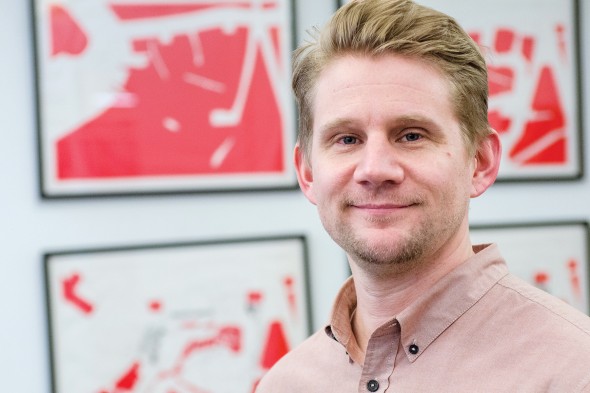Architect looks beyond geometry to think outside the box

Sean Lally considers the waves, particles and chemical properties of energy as a building material. “I think of energy as more than a fuel,” says Lally, assistant professor of architecture. Photo: Joshua Clark
Architects build with steel and stone, wood and glass.
But Sean Lally invites you to consider that energy — its waves, particles and chemical properties — can also be a building material. It’s another way of thinking outside the box.
“In architecture, unsurprisingly, a lot of the interest is in geometry,” Lally said. “Along with the materials that organize our space with walls and windows.”
Filling that space with energy to light, heat or cool it “is like a tire that you fill with air,” said Lally, assistant professor of architecture. “I think of energy as more than a fuel.”
Energy use is a huge issue globally, he said, as governments and industries shift away from fossil fuels to lessen the impact on climate change.
There are obvious differences between forms of energy and the materials for construction that we usually think of. Street lighting, for example: “You can walk through it, unlike a wall,” Lally said.
Another difference: “Street lighting — if you don’t need it, you can turn it off. This building,” he said, motioning to the space around himself, “you can’t turn off.”
But some differences are being challenged.
“There are companies looking at sound that can be focused so that you don’t need partitions — using sound cannons that focus sound so you can have multiple conversations in the same room without hearing each other,” he said.
Lally wrote a book with the intriguing title The Air from Other Planets: A Brief History of Architecture to Come, which came out early last year. The book, he writes, “is a story in which energy emerges as more than what fills the interior of a building or reflects off its outer walls. Instead, energy becomes its own enterprise for design innovation: it becomes the architecture itself.
“The Air from Other Planets is a book nostalgic for the future.”
A brief excerpt:
“The definition of boundaries is one that architects have continually tested and subverted as new materials, construction methods, and social trends have emerged over the centuries.
“It follows that if energy could be controlled and deployed as physical boundaries that define and organize spaces that the human body can detect and recognize, wouldn’t that be architecture?”
Asked to explain the book’s title, Lally said, “I called it this because I felt as if people often have a difficult time thinking about energy and the environments around us as anything other than what they already know and see.
“With NASA’s Kepler Mission under way to identify other Earth-like planets, it was exciting to think how many possibilities exist regarding those planets’ environments when working with essentially the same ingredients.”
He wrote the book during an 11-month fellowship from the 2011-2012 Prince Charitable Trusts Rome Prize in landscape architecture from the American Academy in Rome.
He co-edited and contributed to Softspace: From a Representation of Form to a Simulation of Space, a book of essays on the growing use of digital tools for architectural design that indicate not only form, but qualities such as air, gas, sound, scent and electricity.
Lally was one of seven architects short-listed, from nearly 200 applicants, for the Harvard University Graduate School of Design’s 2014 Wheelwright Prize. His UIC colleague Jimenez Lai, the subject of a UIC News profile in 2013, was also short-listed.
Lally grew up in New Jersey’s Monmouth County. He earned a bachelor’s degree at the University of Massachusetts Amherst and a master’s at UCLA. He taught at Rice University in Houston for seven years before joining UIC six years ago.
Lally lives in Lakeview with his wife, Marina Nicollier, an architect, and their 2-year-old son, George.
He’s the founder of the architectural firm WEATHERS, so named because “we’re manipulating the environment and energies in the environment,” he said.
“Weather is a local condition, microclimates.”
